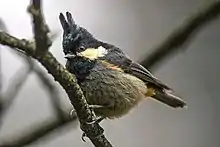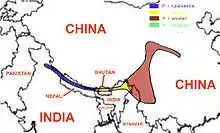Rufous-vented tit
The rufous-vented tit (Periparus rubidiventris) is an Asian songbird species in the tit and chickadee family (Paridae). Some of its subspecies were formerly assigned to its western relative the rufous-naped tit (P. rufonuchalis), or these two were considered entirely conspecific.
| Rufous-vented tit | |
|---|---|
 | |
| Scientific classification | |
| Domain: | Eukaryota |
| Kingdom: | Animalia |
| Phylum: | Chordata |
| Clade: | Dinosauria |
| Class: | Aves |
| Order: | Passeriformes |
| Family: | Paridae |
| Genus: | Periparus |
| Species: | P. rubidiventris |
| Binomial name | |
| Periparus rubidiventris (Blyth, 1847) | |
 | |
| Global range Blue = rubidiventris Yellow = beavani Red = whistleri Green = saramatii | |
| Synonyms | |
| |
Taxonomy
The tit was formerly placed in the genus Parus.[2] The four subspecies are:
- Periparus rubidiventris rubidiventris – S rim of Himalayas from NW to NE India and N Nepal.
- Periparus rubidiventris beavani (Jerdon, 1863) – Beavan's rufous-vented tit – S rim of Himalayas in NE India and Bhutan.
- Periparus rubidiventris whistleri – SE rim of Himalayas in SW China and adjacent N Myanmar and extreme NE India. Sometimes included in beavani.[3]
- Periparus rubidiventris saramatii – Very localised in NW Myanmar.
Distribution and habitat

This tit is a native of the western Himalayas, but has a very large range, occurring in parts of Bhutan, China, Pakistan, India, Myanmar and Nepal. Its natural habitats are boreal forests and temperate forests. In Bhutan for example, P. r. beavani is a rather common all-year resident in moist Bhutan fir (Abies densa) forests, between approximately 3,000 and 4,000 meters ASL. Widespread and by no means rare, it is not considered a threatened species by the IUCN.[4]
Footnotes
- BirdLife International (2016). "Periparus rubidiventris". IUCN Red List of Threatened Species. 2016: e.T22711780A94308455. doi:10.2305/IUCN.UK.2016-3.RLTS.T22711780A94308455.en. Retrieved 12 November 2021.
- Gill et al. (2005)
- Bangs (1932)
- Inskipp et al. (2000), BLI (2008)
References
- Bangs, Outram (1932): Birds of western China obtained by the Kelley-Roosevelts expedition. Field Mus. Nat. Hist. Zool. Ser. 18(11): 343–379. Fulltext at the Internet Archive
- BirdLife International (2008). "Parus rubidiventris". IUCN Red List of Threatened Species. 2008. Retrieved 12 May 2009.
- Gill, Frank B.; Slikas, Beth & Sheldon, Frederick H. (2005): Phylogeny of titmice (Paridae): II. Species relationships based on sequences of the mitochondrial cytochrome-b gene. Auk 122(1): 121–143. DOI: 10.1642/0004-8038(2005)122[0121:POTPIS]2.0.CO;2 HTML abstract
- Inskipp, Carol; Inskipp, Tim & Sherub (2000): The ornithological importance of Thrumshingla National Park, Bhutan. Forktail 14: 147–162. PDF fulltext
External links
 Media related to Periparus rubidiventris at Wikimedia Commons
Media related to Periparus rubidiventris at Wikimedia Commons Data related to Periparus rubidiventris at Wikispecies
Data related to Periparus rubidiventris at Wikispecies
